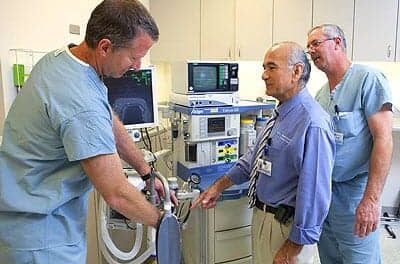 |
Adapt and thrive…or stagnate and become obsolete? The profession of clinical engineering is at a crossroads, and the path we choose will likely lead to one of these outcomes …or the other.
But before considering the nature of the crossroads we face today, it is worth taking a moment to reflect on the path we have been on for the past 30 to 40 years.
Clinical engineering was largely conceived and defined in the 1960s and 1970s to solve a growing problem. That problem came about as technology first began moving into hospitals at a significant rate. Back then, new technology often suffered from a variety of shortcomings. New medical equipment was largely untested and was often of inconsistent quality and reliability. Medical equipment was also often placed in environments with operators who often lacked relevant training and generally were ill equipped to deal with equipment-related problems when they arose. In the 1970s there were also reports that up to 1,200 patients were being electrocuted in the United States each year by problematic medical equipment. These reports caught the attention of The Joint Commission and government regulators, and led to their requirements that hospitals inventory and quarterly test their medical equipment for electrical safety. It was during this period that the health care industry recognized the need for new professionals (“clinical” engineers and “biomedical” equipment technicians) who could provide the infrastructure that would help ensure medical equipment was acquired, maintained, and tested in a manner that provided some assurance of at least its safety.
 |
That was more than 35 years ago. The irony is that while health care technology-related problems have dramatically changed since then, with few exceptions much of what is being delivered to hospitals as “clinical engineering” services has not changed.
Over the decades, medical equipment has become considerably more reliable—fewer moving parts to break down and fewer heat-sensitive components to drift out of calibration. Today, far fewer types of medical equipment benefit from scheduled testing or “preventive” maintenance (PM) because most failures, when they do occur, occur spontaneously in a way that no amount of testing could predict or reasonable amount of PM could prevent. While medical equipment became more reliable, much of it also began incorporating microprocessors in its designs. The widespread use of microprocessors meant medical equipment was becoming, in effect, specialized computers, often with built-in diagnostics that identified device failures before routine testing otherwise could. The “computerization” of medical technology also has led to the integration and networking of formerly discrete medical devices into systems and even systems of systems. The growing trend of integrating and networking medical devices into systems is leading to greater synergies with significant improvements in our ability to diagnose and treat patients more effectively and at an earlier stage. However, integration and networking are also resulting in increasingly complex systems that in turn lead to more and different opportunities for technology failure. This is the nature of today’s problem. What infrastructure and roles are necessary to solve the challenges of today’s health care technology?
A Clinical Engineering Solution for Today
To address today’s challenges, we must first begin approaching the acquisition and support of health care technology from a more strategic level. Any strategic approach to health care technology should be taken within the context of the hospital’s stated strategic service goals. Because medical devices and systems acquired today can often have a significant impact on existing technologies and infrastructure, hospitals need to fully understand the strategic implications of making a technology selection. There should be strategic planning for the adoption, deployment, upgrade, and integration of medical technologies and associated processes. This planning should include a proactive examination of emerging technologies and the infrastructure necessary to support them. There also should be an evaluation of the clinical, technical, and financial benefits of adopting new technologies versus any risk their adoption might introduce. Standardization on technologies and processes should be a goal whenever possible to facilitate consistent operation and effective support. The evolution of existing legacy technologies should be managed, and all the stakeholders affected by technologies should be included in the process.
A security and risk management program focused on addressing the challenges associated with today’s health care technology is also critical. Security management and its integral risk management elements are necessary to identify the most significant issues involving technology and to prioritize the organization’s efforts in addressing those issues. Those efforts are focused on ensuring integrity, availability, and confidentiality of the data that is processed by medical systems and that is necessary for the effective delivery of patient care. Those efforts typically include a combination of administrative, technical, and physical safeguards.
Given the nature of the challenges associated with health care technology today, there exists an immediate need for three new roles … roles into which clinical engineering may have the opportunity to evolve.
The first new role is that of a clinical systems engineer (CSE). The CSE would coordinate an enterprisewide program to ensure the effective deployment, integration, and support of interconnected medical systems. The specific responsibilities would include:
- Maintaining a current inventory of networked and integrated medical systems, including catalog of services, features, interconnections, and configurations;
- Coordinating a security management process, including risk assessment (eg, criticality and probability), vulnerability analysis, and maintaining related documentation associated with interconnected/integrated medical systems;
- Coordinating with stakeholders on a process to prioritize, develop, and implement plans to manage/mitigate identified risks associated with interconnected/integrated medical systems by applying appropriate administrative, physical, and technical safeguards;
- Maintaining the medical device integrity for interconnected/integrated systems;
- Working with stakeholders to ensure the effective deployment, integration, and support of new medical systems into legacy systems, and nonmedical elements of the organization’s information infrastructure;
- Working to ensure systems are deployed into an optimum (ie, secure and supportive) environment;
- Continually reviewing system components to determine which are obsolete or otherwise are no longer adequately supportable;
- Planning for and implementing component upgrades/replacement in a timely manner;
- Identifying and managing appropriate software upgrades, security patches, and antivirus installs for interconnected/integrated medical systems according to industry best practices;
- Conducting root cause analysis (RCA) and failure mode effects analysis (FMEA) on incidents involving integrated medical systems, and reporting findings to appropriate stakeholders for follow-up action;
- Monitoring and adopting industry best practices to ensure the integrity, availability, and confidentiality of data maintained and transmitted across interconnected and integrated medical systems; and
- Educating stakeholders on security and other implications associated with the proliferation of interconnected and integrated medical technologies.
The second new role is that of the clinical systems support specialist (CSSS). The CSSS would be responsible for providing engineering technology support of systems in specific clinical specialties. Examples of these specialties include imaging, cardiology, neurology, surgical, monitoring, obstetrics, and laboratory. The CSSS would be responsible for:
- Maintaining an inventory of all devices, systems, and components in their assigned areas;
- Coordinating deployment of new medical technologies in assigned areas, including planning, needs analysis, evaluations, installation, integration, and training;
- Managing other technology-related special projects in assigned areas;
- Monitoring the operational effectiveness of medical devices and systems in assigned area(s);
- Ensuring devices/systems are effectively maintained by judicious application of scheduled and corrective maintenance, upgrades, and overhauls as appropriate;
- Acquiring, deploying, and utilizing appropriate hardware/software tools to monitor and manage device and system performance;
- Developing or acquiring and deploying administrative, technical, and physical safeguards to maintain the integrity and availability of clinical information maintained or transmitted by medical systems,
- Developing and providing operational and service training to clinicians and support personnel on devices and systems in assigned area(s);
- Providing consultation to clinical staff on technical capabilities and limitations of available technologies;
- Representing technology perspective for assigned area(s) as needed at meetings with other stakeholders;
- Monitoring medical device hazard/recall reports for their assigned area(s) and ensuring appropriate follow-up (ie, communication, corrective action, follow-up);
- Monitoring regulatory developments affecting devices/systems in assigned area(s) and identifying/coordinating appropriate compliance measures;
- Maintaining the technical library and the database information critical to the support of devices/systems in assigned area(s); and
- Participating in the development and maintenance of a capital equipment plan (for existing and new operations for assigned area(s). Examples of plan elements should include needs analysis/assessment, total cost of ownership (TCO) and cost/benefit analyses, and comparative evaluations of other technologies.
The third new role is that of radio frequency spectrum manager (RFSM). The RFSM would be responsible for the enterprisewide management and monitoring of the radio frequency environment. The RFSM would:
- Maintain an inventory of all RF systems operating in or affecting the clinical environment;
- Manage the deployment and operation of RF systems so as to ensure regulatory compliance and to minimize adverse interactions between devices/systems;
- Advise in the selection of compatible RF systems;
- Plan for RF allocation, deployment, integration, and upgrades as necessary;
- Obtain requisite licenses/permits, and ensure all are kept current;
- Investigate reports of possible adverse RF affects on devices/systems, and identify appropriate corrective action as necessary; and
- Educate users and monitor user practices associated with RF systems in order to ensure their safe and effective operation.
Summary
The new paradigm to address today’s health care technology challenges requires an expanded emphasis both on strategic technology planning and security/risk management. These challenges also require new professional roles along the lines of the above-described CSE, CSSS, and RFSM.
The draft standard, IEC 80001 on the Application of Risk Management for IT Networks Incorporating Medical Devices, is likely to have a major impact on the industry when finalized. IEC 80001 substantially validates both the need for strategic and security/risk management as well as the need for two new roles that bear a substantial resemblance to the CSE and the CSSS.
What remains for the clinical engineering community is their decision on whether to evolve into a solution to address the challenges and problems of today’s health care technology…or to remain the solution to problems that have long since disappeared. Adapt and thrive, or stagnate and face increasing marginalization and obsolescence? If we do not evolve into the new paradigm, other professionals no doubt will.
Stephen L. Grimes, FACCE, FHIMSS, FAIMBE, is vice president, enterprise resource planning, at Technology in Medicine Inc, Holliston, Mass. For more information, contact .




